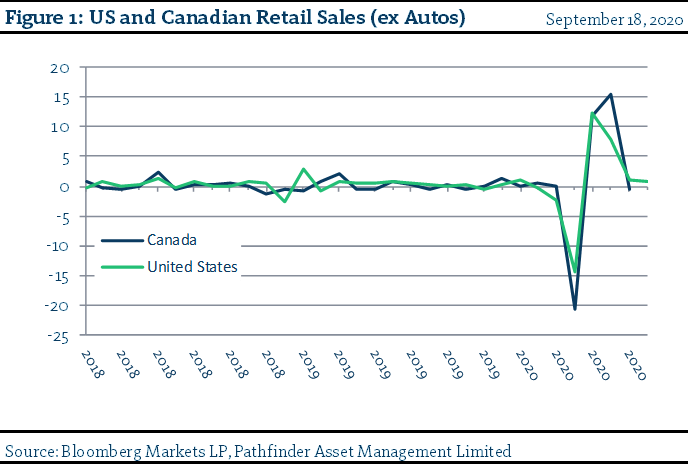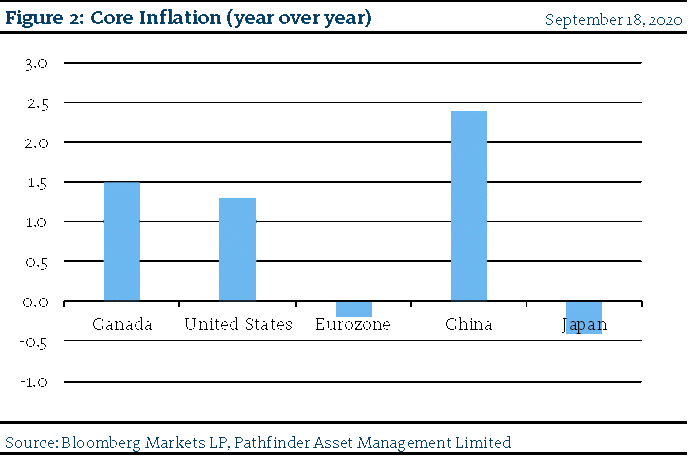We are only part way back (continued….)
We continue this week with our discussion with what appears to be slowing positive change with various economic data points (i.e. a slowing second derivative). As the pandemic began to make its way across the globe and the recession started, many investors and policy makers put forth a “V shaped” recovery as a hopeful thesis. This would imply that the bounce back would be as strong as the drop was sharp. While this has apparently happened in the stock market, it appears that a different trend in the regular economy is developing. China, by far and away, had the best economic recovery. Europe seems to be improving on a more consistent basis and North America is somewhat mixed. In particular, the US, while appearing to have reached a bottom, has come back partially with slowing improvement in recent months. Travel, office attendance, hotel reservations and restaurant traffic seem to be hovering at around 50-60% of what they were before the pandemic and consumer confidence has been mixed (the consumer is 66% of US GDP).

- Continuing the focus on the consumer, Figure 1 presents retail sales data with auto purchases removed for both Canada and the US as I wanted to get a look at how general purchases have responded. As you can see, it looks like there has been a strong snap back in both countries, which is good. However, these data series do not contain spending on leisure and hospitality, which is below trend as noted above.

- We also present inflation data in Figure 2, for various parts of the world. Generally, investors do not like inflation, and it has been depressed globally since the Great Financial Recession. Central banks have tried to manage this, which has led to asset inflation only and some serious geopolitical issues with the creation of substantial economic disparities. At this point, some inflation would be healthy (our opinion) because it would imply higher wages and more disposable income for the consumer. We will be watching this closely as we believe that this needs to change over time.
“This means that” while our thesis from last week has not changed, we will pay strict attention to this over the coming months. For the next few weeks, we will digress into company specific Investment Outlooks and will pick up the macro discussion again once when we have more data and conclusions to discuss.
National Instrument 31-103 requires registered firms to disclose information that a reasonable investor would expect to know, including any material conflicts with the firm or its representatives. Doug Johnson and/or Pathfinder Asset Management Limited are an insider of companies periodically mentioned in this report. Please visit www.paml.ca for full disclosures.
*All returns are time weighted and net of investment management fees. Returns from the Pathfinder Partners’ Fund and Pathfinder Real Fund are presented based on the masters series of each fund. The Pathfinder North American Equity Portfolio and The Pathfinder North American Income Portfolio are live accounts. These are actual accounts owned by the Pathfinder Chairman (Equity) and client (High Income) which contain no legacy positions, cash flows or other Pathfinder investment mandates or products. Monthly inception dates for each fund and portfolio are as follows: Pathfinder North American Equity Portfolio (January 2011), Pathfinder North American High-Income Portfolio (October 2012) Pathfinder Partners’ Fund (April 2011), Pathfinder Real Fund (April, 2013), and Pathfinder International Fund (November 2014).
Pathfinder Asset Management Limited (PAML) and its affiliates may collectively beneficially own in excess of 10% of one or more classes of the issued and outstanding equity securities mentioned in this newsletter. This publication is intended only to convey information. It is not to be construed as an investment guide or as an offer or solicitation of an offer to buy or sell any of the securities mentioned in it. The author has taken all usual and reasonable precautions to determine that the information contained in this publication has been obtained from sources believed to be reliable and that the procedures used to summarize and analyze such information are based on approved practices and principles in the investment industry. However, the market forces underlying investment value are subject to sudden and dramatic changes and data availability varies from one moment to the next. Consequently, neither the author nor PAML can make any warranty as to the accuracy or completeness of information, analysis or views contained in this publication or their usefulness or suitability in any particular circumstance. You should not undertake any investment or portfolio assessment or other transaction on the basis of this publication, but should first consult your portfolio manager, who can assess all relevant particulars of any proposed investment or transaction. PAML and the author accept no liability of any kind whatsoever or any damages or losses incurred by you as a result of reliance upon or use of this publication.